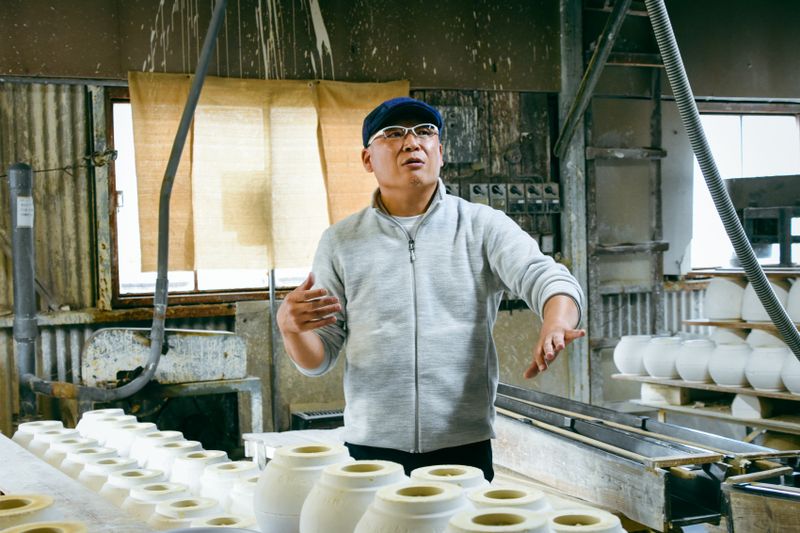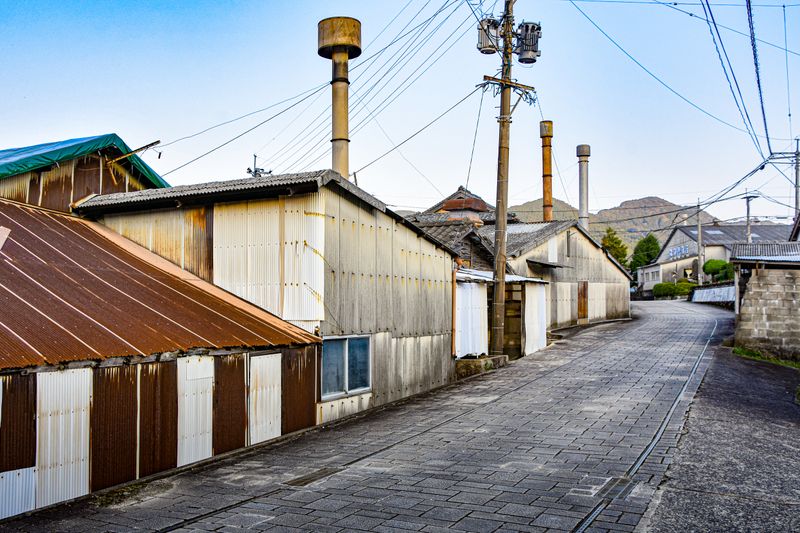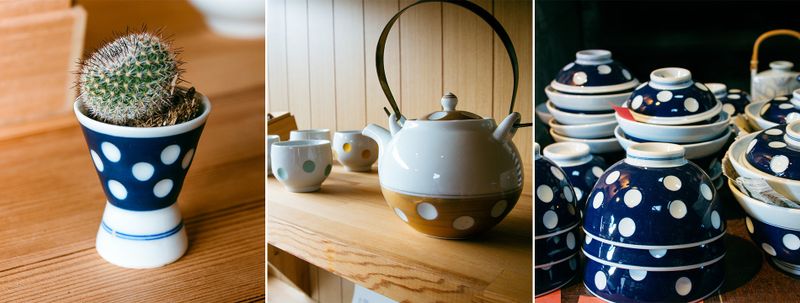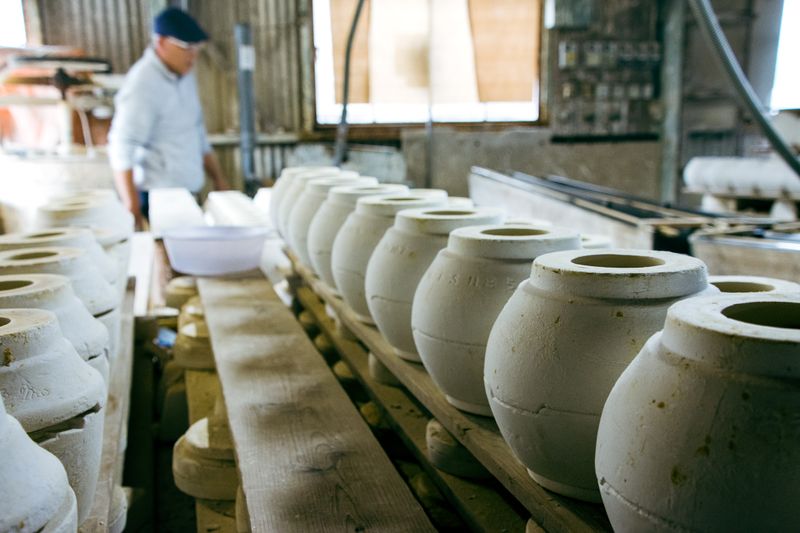Feb 8, 2022
The Ureshino Story: Potters lend their craft to showcase region’s natural resources
The city of Ureshino in Saga Prefecture, southwestern Japan, is home to the proud cultures of Ureshino tea, onsen (hot springs) and porcelain. This is the third in our series of articles on City-Cost showcasing the forward-thinking, local creatives from each of these respective industries who have joined forces to help safeguard the future of Ureshino's cultures.

The city of Ureshino in Saga Prefecture sits on a creative faultline where natural resources have collided to produce three long-standing traditions going back hundreds, in some cases over one thousand, years.
Up on the precipitous and verdant mountainsides farmers grow Ureshino tea. At lower altitudes the very earth itself is molded and heated to create the finest porcelain. Closer to town traditional onsen ryokan harness natural, steaming hot spring waters and their skin-beautifying properties.
“In Ureshino, the raw materials are great and there are a lot of them. Saga Prefecture has two seas on either side, the Genkai Sea and the Ariake Sea. There are mountains, cattle, pigs. The natural resources are amazing,” local potter Kenichi Soejima said.
“It’s just that the people of Saga Prefecture aren’t conscious of this. We’re not.”
Maybe they are, though, deep down. According to Soejima, people in Tokyo often remark of visitors from Saga that, “whatever food we serve them, they never say how delicious it is,” implying that the visitors can get better back home. “Except for maybe the tuna,” he speculated.
When he has visitors from Tokyo around this time of year, Soejima recommends that they buy some of the oysters which come in from the fishing ports of Saga and others in the region, and then they BBQ them in the grounds of his kiln.
If you want something more elaborate, maybe it’s better to go to Tokyo. When it comes to tasting raw ingredients though, “we can’t lose.”
“That's why we think it's better to show our hospitality to people who come from outside of Kyushu in this way. Rather than going to, say, a bad restaurant, it’s better to showcase our own natural ingredients,” Soejima said.
Indeed, the visitor’s experience of Ureshino will likely center on one of the region’s three core traditions - tea, onsen, or porcelain - all of which are born from, and showcase, local and natural resources.
In recent years leading figures from each of Ureshino’s three industries, Soejima among them, have come together in the formation of Ureshino Chadoki - a project that started out by putting on related events and now strives to secure the future of the local tea, onsen and porcelain traditions.
Through Ureshino Chadoki, as well as initiatives like Tea Tourism, Soejima and his peers are strengthening the appeal of their related industries and maybe even adding a touch of sophistication to proceedings, perhaps to make things more palatable for those of us softened by urban living.
What has come from this is maybe the crowning glory of the Ureshino experience for many visitors, to take their Ureshino tea from one of the city’s beautiful “tea spaces” - terraces and pergolas constructed in the heart of tea plantations, some boasting panoramic views - on which tea is served in the finest porcelain by tea experts clad in crisp white uniforms.
One doesn’t have to look too far beyond the instabae appeal though to see that at the heart of this experience is a journey up into the mountains to the farmer’s plantations, to enjoy the taste of locally grown tea, brewed and poured by the very farmer who produced it, sipped from porcelain tableware crafted by the hands of local potters.
Where Ureshino’s tea might be tasted in the soaring heights of the plantations or in a luxury ryokan bar downtown, the porcelain tableware in which it is often served is crafted much closer to the earth.
Soejima’s Soesen kiln is one of a number of pottery operations located in a quiet area southeast of downtown Ureshino - a townscape of stone and corrugated iron with squat kilns lining the narrow lanes, their chimney’s protruding into the sky.

(Hizen Yoshida-yaki kilns, Ureshino, Saga Prefecture.)
It’s here that local potters have been producing their Hizen Yoshida-yaki porcelain for around 400 years, a craft thought to have been imported by Korean potters in the late 16th century, and guarded by feudal lords until the Meiji era.
In the post-war years the simple polkadot designs of the porcelain tableware produced by Ureshino’s potters became something of an industry standard - in part for its production efficiency in the face of post-war labor shortages - and was a staple of Showa-era dining tables across Japan.
For his own part Soejima, an Ureshino native, has been working at his family’s kiln since he was 25, returning to the region after cutting his teeth in the industry in Tokyo - serving an apprenticeship of sorts on Kappa-bashi Dori, the famous “kitchen street” in the capital’s Asakusa district.
“More than my parents, it was the people around me who would say things like, ‘you’re going to be the next generation (of potter),’” Soejima told us during a visit to his kiln.
“I liked to make things though and when I realized that the material I could use to do that could be clay, then that was kind of the beginning for me.”
With Soesen he continues to build on the polkadot designs, the staying power of which he puts down, in part, to featuring in the long-running animation Sazaesan, a Sunday-evening television staple for many homes in Japan.
“(The design) was a regular feature in community centers. Nowadays young people don’t really use such places but it’s something you see in Sazaesan, so it's imprinted on people’s consciousness. Because of this it even has a sense of nostalgia for younger people,” he explained.
To create the polkadot effect of Soesen’s porcelain tableware, Soejima employs a technique known as “kakiotoshi” in which a white clay coating is applied over a brown base and then scraped off to reveal the dots. It’s a technique which is rarely used today, according to Soejima.
“It's no fun to stick to just this, though,” he said of the classic design.
“The people who like it have already bought-up most of our stuff, so we need to release the next one, to make something new and different.”
Soejima and his collaborators have certainly been taking the design to new levels, reaching new audiences. In 2010 Soesen along with fellow Ureshino potters Soemasa took out the Good Design Long Life Design Award for their polkadot tableware series.

(Soesen porcelain, Ureshino, Saga Prefecture.)
“This is the kind of industry where you have to be constantly experimenting and trying new things,” he said.
“Before, what might have been seen as a mistake (in the creative process) is something that I want to show in a different light. It's like taking the current way of doing pottery, which might be taboo now, and doing it because it might not be taboo in 10 years.”
Not that his is a relentless pursuit of perfection. In fact Soejima and other Hizen Yoshida-yaki potters have been embracing some of the imperfections that are the almost inevitable result of human hands dealing with raw materials.
Through the Ekubo to Hokuro initiative Soesen and other kilns in Ureshino have been using some of the imperfections that come with hand-crafting porcelain tableware to bring visitors and potential customers closer to the heart of the production process.
The terms “ekubo” and “hokuro” are industry terms of endearment that refer to pinholes and spots, imperfections caused by iron in the glaze - as well as a reflection of the wider handmade processes - that might appear in finished porcelain items, making them unsuitable for conventional retail markets.
Potters like Soesen participating in Ekubo to Hokuro showcase these items at their on-site stores to reveal their functionality and provide visitors with insights into the production process, bringing people closer to the richness of Ureshino’s natural resources.
Where there is an abundance of natural resources though, there is often to be found a lack of the human resources needed to make the most of them, especially in the world of traditional crafts. Hizen Yoshida-yaki being no exception.
“In terms of the population decreasing, that’s happening all over. It’s not something that I can stop from happening on my own,” Soejima explained.
Nor has Soejima’s participation in groups like Ureshino Chadoki been born out of any sense of crisis facing Ureshino’s traditional industries.
“To be honest, even just trying to remember the techniques and all the history (of this pottery work), there’s a tremendous amount of it. That alone is tough, and it’s something you have to learn with your own hands, too. If you get someone new in and tell them to do it, well, if they don’t like it, it’s not going to work out.”
“On the contrary, I have to do my best and make the best products I can so that others might see this and want to do something similar. People have to see that we are doing something we enjoy, something interesting. It has to be that way, I think.”
Looking around Soejima’s kiln what people will see is a workspace littered with the tools of his craft, shelves stacked with molds, items waiting to be glazed, paint splashes on the walls, and packed earth underfoot - the potter’s world perhaps, and one that appears a long way from the perfection of recent Ureshino tea experiences planned and showcased by creatives like Ureshino Chadoki.

(Kenichi Soejima’s workshop at the Soesen kiln, Ureshino, Saga Prefecture.)

(Kenichi Soejima, Soesen’s Yoshida Chashitsu, Ureshino, Saga Prefecture.)
Just around the corner though is Soesen’s Yoshida Chashitsu. Warmly lit, walls lined with the soft tones of bamboo, and carefully presented, the chashitsu was converted from a traditional storehouse and now serves as one of Ureshino’s tea spaces as well as a gallery for Soesen porcelain.
The chashitsu and the kiln appear indicative of the contrasting worlds in which Soejima and his Hizen Yoshida-yaki porcelain exist, as do others who work in Ureshino’s traditional industries.
Whichever world the visitor to Ureshino chooses to see though - hopefully both - they’ll come away with the privilege of having come to know and experienced this region's special natural resources, which is as it should be for people like Soejima.
This article was supported by Ureshino Chadoki.



0 Comments